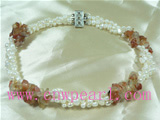
La Paz Oyster ‘Pinctada Mazatlanica’
Before the discovery of the Pacific’s black-lipped oyster the only other Mother of Pearl that came close to the beautiful colors of the oysters of Polynesia came from the La Paz oysters in the waters of Panama and California. At one time La Paz oysters, preferring open oceanic conditions, were near extinction but recent culturing ventures in the Gulf of California are replenishing numbers and seeing a return of black pearls and Mother of Pearl to the world market.
Mabé Oyster ‘Pteria Penguin’ and ‘Pteria Sterna’
These two species of thin-shelled oysters are the most common sources of mabé blister pearls. Mabé pearls are artificially induced or cultured, they form when a mold made of plastic is inserted between the oyster's shell, this causes the oyster to produce layers of nacre or Mother of Pearl which eventually covers the mold, the mould is then cut from the shell. These oysters occur naturally in the Red Sea, Indian Ocean, and the tropical western Pacific.
Mother of Pearl Facts
All waterborne organisms living within shells, called mollusks, have the ability to produce Mother of Pearl. However, very few mollusks with single shells, called gastropods, do so. High quality Mother of Pearl is produced by the mollusk family called bivalves, which have two-part shells.
I went shopping with my friends and find a interesting thing .We find a lot of wholesale sterling silver jewelry, pearl pendant, cultured pearl earings, freshwater pearl ring, cheap round freshwater pearls, loose freshwater pearls, pearl strands, green turquoise jewelry, wholesale pearl beads … in pearl wholesale store. All that pearl jewelries are designed with the best and the top d they offer all these types of pearl jewelry at deep discounted wholesale prices. I advise you to have a look. Do not go wrong.
No comments:
Post a Comment